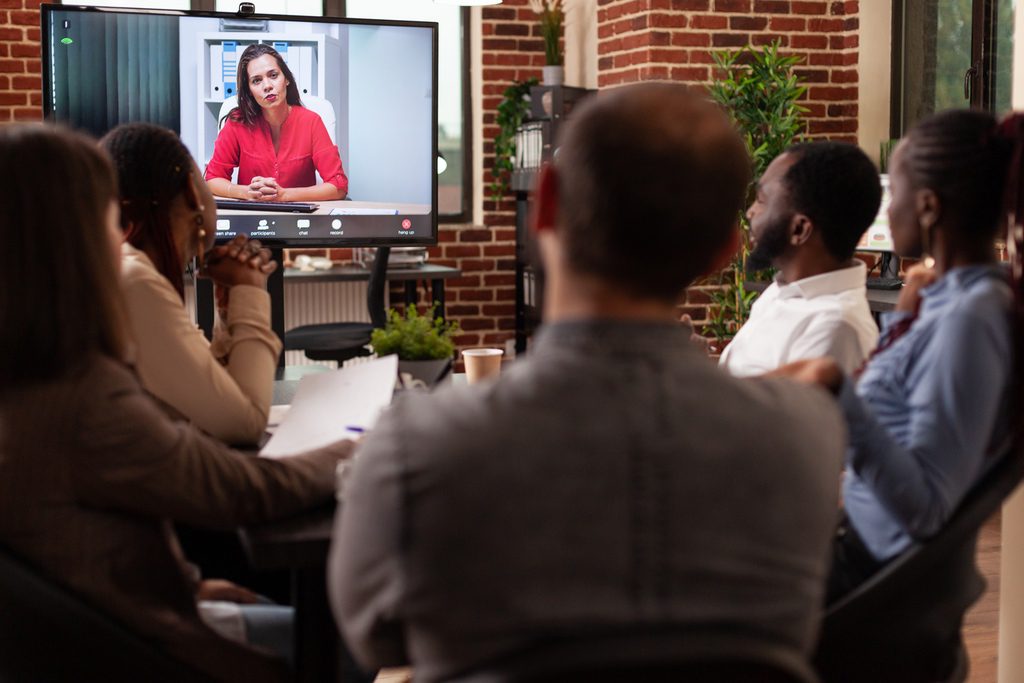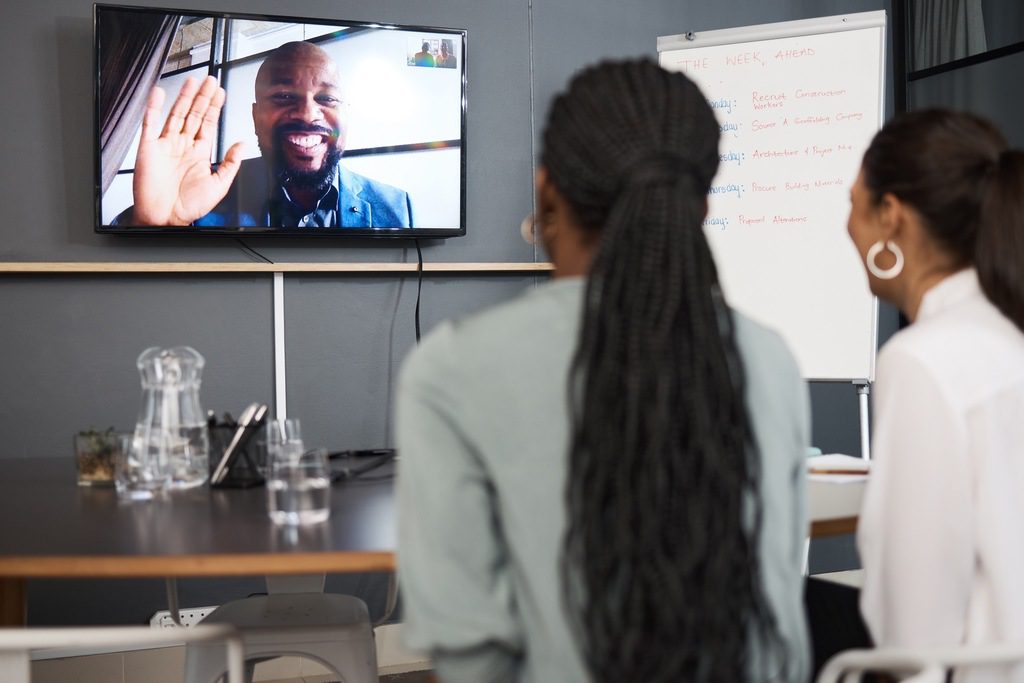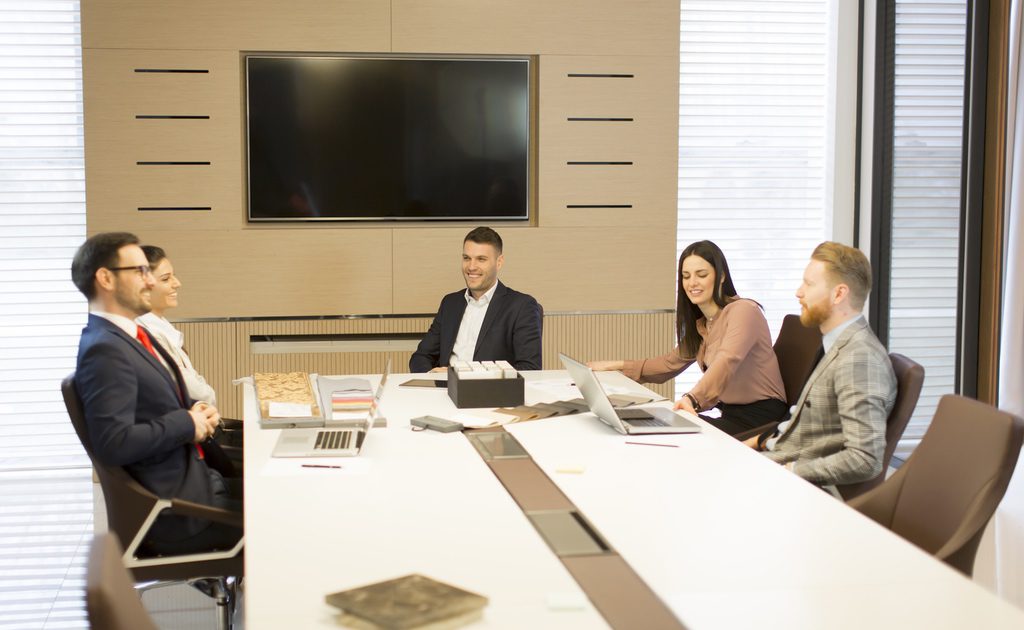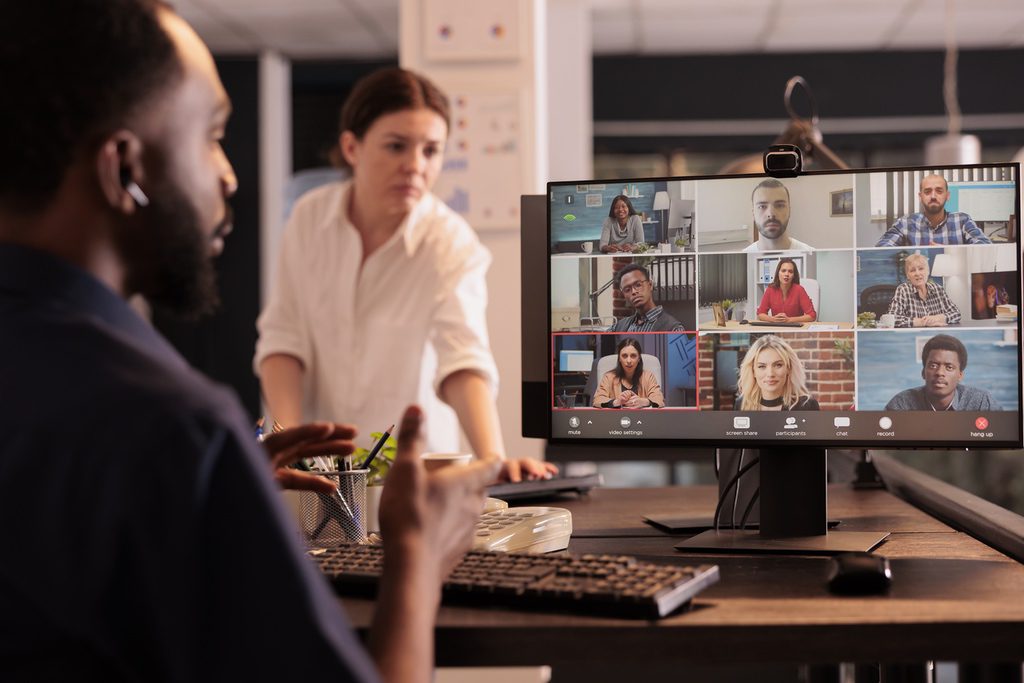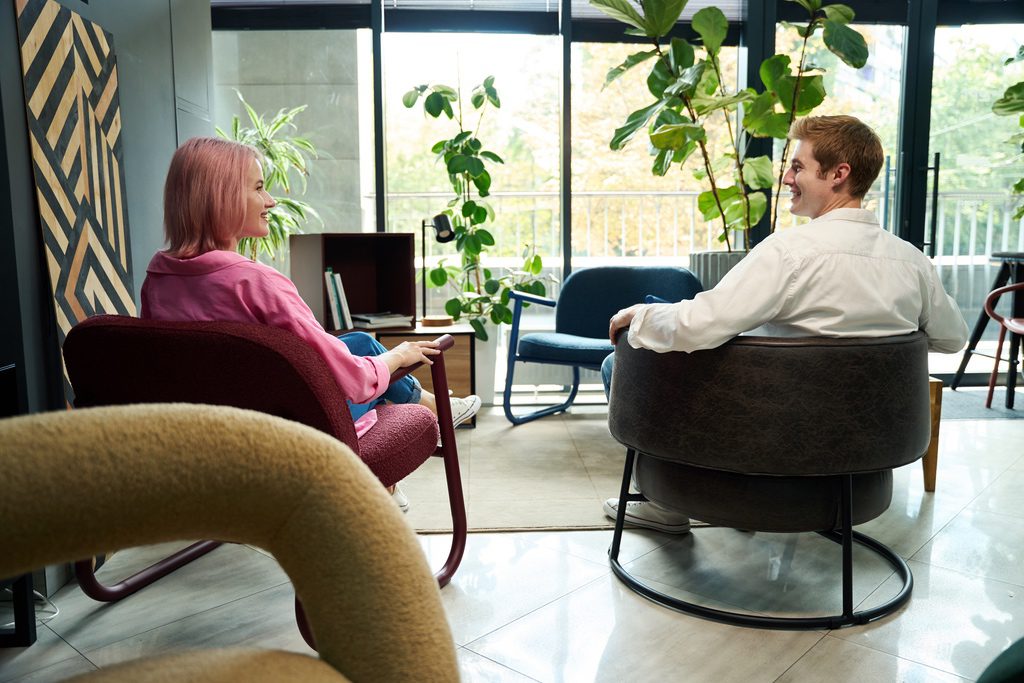Making hybrid happen: six principles for technology integration
Many companies have adopted new technologies to support hybrid collaboration without alignment to strategic intent. ET Group proposes six principles to support a more integrated approach
Reposted article from WORKTECH Academy
Hybrid collaboration has become central to the new world of work, forming a backbone for how organisations operate, generate new ideas and connect with colleagues.
But getting this aspect right so that all meeting participants share a high-quality experience, irrespective of whether they are joining in-person or remotely, is proving a challenge for many companies.
In this article series, Canadian workplace technology designer and integrator ET Group and WORKTECH Academy have been exploring how different aspects of the workplace must be reconsidered in order to create effective hybrid collaboration.
Our first article in the series presented a core hypothesis that neither investment in new technology nor redesign of meeting space could be sufficient on their own to move the dial; instead, the issue of meeting equality was linked to underlying social interactions and organisational values.
Our second article validated this hypothesis in an online workshop with a group of 30 international companies drawn from WORKTECH Academy’s membership network. This confirmed that three out of four barriers to hybrid collaboration identified by workplace professionals are ‘below the waterline’ and deeper-rooted in company culture than the more visible and tangible aspects of technology and space.
Our third article in the series encouraged company decision-makers to orient themselves for strategic action regarding hybrid strategy and provided a ‘hybrid rainbow alignment tool to help them do so.
Focus on technology
In our fourth and final article, we look specifically at technology. For many organisations, investment in new technology has been their way to the move towards hybrid working. But integrating new technology into hybrid workspaces demands a nuanced approach that values the intricacies of distributed work.
Sometimes, these investments have been made without in-depth strategical thinking about the distributed working policies of the organisation, as well as the needs and wants of their staff. Companies can then get stuck with technologies that remain static for years as they are not adaptable to the company’s needs as it iterates and grows.
ET Group’s ‘hybrid rainbow’ , visualizing the distributed work spectrum, is a straightforward and effective tool for arriving at a suitable approach to distributed working; it not only highlights the diversity of strategies that are possible, but also helps carve out the approach that is the best fit for any individual team or organisation.
But irrespective of your team or organisation’s chosen path, we propose that there are six principles – made up of two trios – that can help support the ways in which companies adopt and integrate new technologies into their workspaces. Following these governing principles, companies should be empowered to make better technology decisions for themselves, thereby boosting the effectiveness of their hybrid collaboration.
The initial trio focuses on technology implementation specifics, while the latter trio encourages a broader perspective. These principles are based on ET Group’s ‘four pillars’ of hybrid collaboration, which highlight the interaction between technology, space, social interactions and organisational paradigms.
Six core principles
- Principle 1: Unified Platform and Interoperability
To ensure a consistent and frictionless user experience, organisations should opt for a singular unified communication platform for all of their internal communications. Ensure this platform can interoperate with other platforms that your key clients and partners use, thereby facilitating seamless collaboration beyond organisational boundaries.
- Principle 2: Human-Centered Design
Embrace a human-centered approach to technology design. Acknowledging the diversity of user needs based on their role, location, and relationship to the organisation is critical, depending on how individuals choose to work, how they engage with the technology that you provide will differ.
Prioritise a frictionless, simple, and flexible user experience that fosters inclusivity, paying close attention to video, acoustics, lighting to support clear participation for all. You should also consider the new collaborative practices you are trying to enable and any challenges that your teams currently face with your collaboration to see how you might overcome them.
- Principle 3: Prototyping and Learning
Don’t skip the prototyping and testing phase! It is important to see new technologies at work in controlled environments. Getting into the practice of testing can increase the confidence with new technologies, not just by IT experts but by a broad spectrum of users. This would allow you to adapt more swiftly to technological advancements and ensuring a smooth transition to broader implementation.
- Principle 4: Comprehensive Support Programme
Develop a support programme that includes proactive assistance, remote monitoring and specialised help. Technology should serve as a cornerstone of the hybrid work strategy, facilitating collaboration and productivity in diverse settings. This involves not just providing technological support but also supporting employees as they adapt to new teaching and working styles, in order to maximise the benefits of hybrid meeting technology and ensure psychological safety.
- Principle 5: Awareness and Accountability
Cultivate awareness and responsibility among team members, especially those working remotely, to maintain a high standard of interaction. All the efforts for meeting equity and the like become obsolete if remote participants do not assume accountability for the tech they use. Employees need to grow their awareness for using proper audio and video equipment when working from remote. In addition, using a lack of bandwidth for turning off video should start a conversation on whether the remote setting is the best to use. Add to it the background setting, and you have the ingredients for creating awareness and considering accountability. Encourage an environment where every interaction, whether in-person or remote, is hosted with the highest regard for quality and participant engagement.
- Principle 6: Embracing the human elements of technology adoption
It’s important to recognize how new technologies affect not just the technical aspects of our work, but also the social dynamics and organizational paradigms that exist within a company. It’s about recognizing that when new tools are introduced, they can and most likely will change the way people interact with each other and how work gets done. By being mindful of these dynamics, companies can proactively navigate the evolving landscape of hybrid work environments. This might include cultivating new ways of managing distributed teams, renegotiating expectations, identifying shifts in power dynamics, and re-evaluating foundational beliefs about work and productivity.
‘Being mindful of these “hidden” interdependencies and impacts on collaboration is crucial…’
To conclude, as we navigate the complexities of integrating technology into hybrid workspaces, these six principles serve as a helpful set of guidelines. They encourage not just mindful technological adoption but also a holistic re-evaluation of working practices, organisational culture and interpersonal dynamics in order to foster a truly inclusive and effective hybrid working environment.
How to Make Corporate Real Estate Decisions for a Hybrid Workforce: Best Practices & More
Summary:
- Hybrid work brings challenges like variable occupancy and space utilization, which require businesses to reevaluate how they use their corporate real estate.
- Implementing technologies like video conferencing systems and hot desking software is essential to facilitate effective communication and efficient use of space in office environments.
- Regularly collecting feedback and engaging in discussions with employees helps align real estate decisions with the actual needs of the workforce, enhancing productivity and satisfaction.
- Key strategies include investing in scalable technologies, focusing on flexible spaces, and regularly reviewing real estate usage to adapt to ongoing changes in work dynamics.
How to Make Corporate Real Estate Decisions for a Hybrid Workforce: Best Practices & More
Organizations of all kinds are quickly learning that hybrid work is the new normal—and that they need to adapt or risk being left behind. That doesn’t just mean investing in hybrid technology solutions like video conferencing systems; it also means reevaluating space requirements and usage to optimize efficiency and accommodate the changing needs of the workforce.
In other words—your business needs a corporate real estate plan that accounts for the new ways people work and the new tools they need. Below, our team at ET Group provides a guide for evaluating your needs and implementing effective solutions.
How Hybrid Work Is Changing Corporate Real Estate
Hybrid work is increasingly popular with employees—in fact, 87% of workers who are offered the option end up taking it. But it also creates challenges for organizations, not the least of which have to do with the way corporate real estate is used.
Here are some of the most pressing real estate problems businesses face in the hybrid era:
- Variable Occupancy: Predicting office attendance can be challenging now that employees increasingly choose to work from home or in the office on different days.
- Space Utilization: Underused spaces can be a financial burden, while overused areas can lead to overcrowding and reduced productivity.
- Communication & Collaboration: Hybrid workplaces must include technology that allows remote and in-office teams to work together effectively in real-time.
- Employee Well-being: Since so many employees have the option to work remotely, businesses must invest in spaces that people want to work in—or risk their occupancy rates dropping.
But take heart—these challenges can be overcome with the right strategy and technology. It all starts with considering the needs of the people in your organization and how to meet them with modern solutions.
3 Easy Steps for Assessing Your Business Spaces
Start by being honest about your workplace. Understanding the experiences that your spaces provide for team members provides valuable insights you can use to make them more appealing and efficient. Here are some steps you can take:
Collect Space Utilization Data
How often are people using your spaces? When? For how long? Answering questions like these can help you identify the types of spaces that are most useful for your business.
Learn More: Workplace Occupancy Metrics That Can Help You Better Optimize a Business Meeting Space
Do you need more focus spaces where employees can work by themselves or in small groups? Or is there a need for more conference rooms where whole teams can collaborate, either in-person or with remote members?
It’s better to make these decisions based on measurable data rather than trying to guess and risking the wrong investment. Workplace analytics provide a clear picture of the way people are using your spaces so that you can upgrade them to offer a more supportive and productive experience.
Start a Conversation with Your Team
The feelings and opinions of your team members lend valuable context to the data you’ve collected. This helps ensure that any new tools, space upgrades, or strategies you choose are aligned with the needs of your employees.
The best way to figure out what your team needs from their office space is to open up a dialogue. Hosting workshops for hybrid workplaces can give you an opportunity to unpack old ways of thinking about the workplace and come to a mutual agreement on new practices that support your personnel while meeting your organizational goals.
Analyze Costs vs. Benefits
Once you’ve looked at how your team members are using your spaces and spoken with them about their needs, you can start to plan upgrades. But investing in space upgrades or new technology always comes with a cost, so it’s vital to understand what you can expect to gain before making these commitments.
Professional guidance is essential here. Working with an audio visual consultant helps you create a harmonized technology stack that offers predictable ROI—instead of mixing and matching products or systems that may not be compatible or serve your goals.
Must-Have Technology for Efficient Hybrid Workspaces
When you engage a consultant to help your corporate real estate plan align with the realities of hybrid work, you’ll receive recommendations for several technologies. Here are a few of the staples for modern office spaces.
Video Conferencing Systems
Reliable video conferencing is critical for teams that have remote and on-site team members working together regularly in real time—but it can also help you make better use of your meeting rooms.
Learn More: Calculate the ROI For Your New Video Conferencing System
Investing in high-quality audio video conferencing technology can reduce the need for large meeting rooms by allowing for effective virtual gatherings. This shift can lead to a significant reduction in required physical space—solving the space utilization problem while supporting communication and collaboration.
Hot Desking Software
The practice of “desk hoteling” has become central to the concept of the hybrid office. Using software that allows hybrid workers to schedule their own in-office hours can help you make the best use of available corporate real estate by eliminating the wastage associated with permanently assigned but often empty desks.
By implementing hot desking, companies can maintain smaller office footprints, which reduces real estate costs while still providing adequate workspace for employees when they choose to work onsite. This also helps reduce the risk of scheduling conflicts from variable occupancy.
Learn More: How to Make Hot-Desking Work for Your Hybrid Environment
Best Practices for Optimizing Corporate Real Estate in the Hybrid Era
As you optimize your business spaces for hybrid, here are a few principles to help guide your decision-making:
- Redesign for humans. Focusing on the needs of employees in your office spaces helps prevent spending on technology that doesn’t improve their experience or quality of work. Learn more about how to optimize employee well-being with human-centered design practices.
- Focus on flexibility. Most hybrid workspaces need a few areas that are versatile enough to adjust for different occupancy levels and types of work. Often called “flex spaces”, these environments often include modular design features and audio visual technology that can quickly be deployed when needed.
- Invest in scalable solutions. Technology should be able to keep pace as your business grows—and as you find ways to use less space. Using cloud-based software and remote tech support options can help you meet the needs of growing teams and shrinking offices.
- Review your plan regularly. The needs of your workforce and the nature of hybrid work will continue to evolve. Tracking your real estate usage and employee feedback helps you adapt your strategy accordingly.
Future-Proofing Corporate Real Estate with ET Group’s Hybrid Solutions
The mix you choose between remote and office-based work, the physical layout of your spaces, and the technology that supports your operations all play a critical role in setting up an efficient hybrid workplace. Changes to your corporate real estate plan should start by changing the way you and your team think about hybrid work—then follow through by augmenting your space and the technology in it accordingly.
At ET Group, we help organizations of all kinds transition effectively to hybrid workplace models. Our approach is based on in-depth consulting to provide space and technology solutions that support the individual goals of each business that partners with us. Reach out to book a discovery call with us today.
Stay connected with us:
Follow ET Group on LinkedIn
Subscribe to ET Group’s YouTube Channel
Essential Hybrid Workplace Technology to Support Your IT Staff in 2024
Summary:
- Integrating advanced hybrid technologies supports IT staff by automating routine tasks such as room testing and remote monitoring. This can help your organization manage a decentralized network of endpoints and ensure more seamless audio-visual communication.
- End-user training enhances the adoption and efficient use of new technologies by both IT and general staff, reducing the support load on IT personnel and fostering an environment of self-sufficiency within hybrid workplaces.
- Utilizing workplace analytics and insights allows IT teams to preemptively troubleshoot and resolve potential issues, minimizing downtime and improving productivity through data-driven decision-making.
- Delegating tasks such as audio-visual support and meeting room maintenance to specialized external providers like ET Group can free up in-house IT staff for more strategic initiatives, optimizing resource use and boosting operational efficiency.
Essential Hybrid Workplace Technology to Support Your IT Staff in 2024
The role your IT staff plays changes when your workplace goes hybrid. It’s no longer enough to have a few tech experts on-site to reset routers—you now need to be able to address potential issues across a decentralized network of devices. There’s also a more pressing need to monitor the audio visual technology your team depends on for seamless communication and ensure it can function properly.
Training your team to embrace the potential offered by hybrid workplace solutions is part of the solution—but so is investing in technology that will provide adequate support. Below, our team at ET Group shows you several different kinds of hybrid technology and how they can benefit your IT staff in the current era.
Why End User Training Is Essential for IT Staff in Hybrid Workplaces
End-user training does more than just encourage AV tech adoption in your workplace. It also brings your internal IT staff up to speed with the needs of your tech stack so that they can deliver more effective support.
At ET Group, we provide consulting for hybrid workforces that can help your team:
- Understand the limitations of your current technology (including compatibility, security, and UX)
- Identify new technologies to bridge these gaps
- Optimize your space to be maximally efficient and productive
- Embrace the potential of your upgraded workplace for better ROI and productivity at all levels
We also offer workshops for hybrid teams to identify and implement new ways of working. These can be useful for both IT and general staff, ensuring their comfort with any upgrades you need to make so that your workplace can meet the demands of the modern era.
Key Technologies for IT Teams in the Hybrid Age
So what specific technologies do modern IT teams require? The answers differ depending on the size of your organization and the industry you work in—but in our experience, here are the most useful upgrades you can make to your tech stack:
Workplace Analytics & Insights
This service provides up-to-the-moment information about the way your video conferencing systems and other communication technologies are being used. Through ET Group’s workplace insights, you’ll gain valuable data about:
- Meeting usage stats
- Room capacity and availability
- Failure rates
- Incident frequency
- User adoption metrics
- Improvement opportunities
… and more. Your leadership team can then use this data to validate strategic decisions about the spaces and technology you use. For example, high rates of failure for a particular piece of equipment may point towards a need to upgrade or replace it—while consistently high room capacity in a certain type of space may indicate a need for more similar spaces.
Automated Room Testing
Struggling with room or equipment settings before meetings is bad, but having to put a meeting on pause to deal with a sudden hardware or software issue is even worse.
Our automated room testing checks the settings for your audio-visual equipment between calls or video meetings and reverts them to the defaults (or optimal settings chosen by your administrators). This creates consistency for users and saves time by reducing delays from technical difficulties.
- Run scripts between meetings or on custom schedules
- Restore settings like speaker volumes, HDMI inputs and outputs, microphone settings, lights, and room temperature
- Keep scripts running while rooms are in use to restore normalcy quickly if equipment fails
Remote Monitoring
Remote monitoring and support allow you to monitor with real-time detection from your entire AV network (including endpoints located off-site).
Remote Monitoring and Management allows you to monitor the state of your system while being alerted when a problem arises. This allows your IT Team to:
- Diagnose issues in real time
- Take a proactive approach to system maintenance and troubleshooting
- Reduce lost time and revenue by providing expedient and accurate solutions
An Outsourced AV Help Desk
Responding to tickets takes up valuable time for in-house IT staff, who are often stretched thin as it is. Outsourcing the responsibility of fixing audio-visual problems to experienced technicians frees up time and energy for your in-house team to handle other critical tasks.
Working with ET Group can give your organization access to a help desk that can take over any or all of the following:
- Logging incidents and initial troubleshooting
- Second-level remote diagnostics from certified professionals
- Dispatching technicians and assigning resources as needed
- Managing and closing tickets
Support from Meeting Room Technicians
Having a full-time, on-site technical resource with an in-depth understanding of your meeting room technology can improve your spaces, tools, and organizational culture. When you work with ET Group, our meeting room technicians provide:
- Timely and accurate responses to incidents and service requests. This means your in-house IT staff won’t have to drop what they’re doing anytime there’s an issue or emergency in one of your meeting rooms.
- Incident escalation protocol that ensures urgent matters are always reported to skilled field service technicians for advanced solutions.
- Hands-on support that keeps key meetings and events running on time and as planned.
Leveraging External Resources for Future IT Success
Your in-house IT staff have a lot of important work on their hands already—and the more advanced your tech stack becomes, the easier it will be to stretch them too thin. Outsourcing key services and investing in the right technology is often the most immediate and cost-effective way to upgrade your office and network for efficient hybrid work—and ET Group is ready to help.
Book a discovery call with us to learn more about how we can help you bring your organization comfortably into the age of hybrid and remote work. From consulting and employee workshops to technology buying, systems installation, and ongoing support, our AV experts have your needs covered.
Frequently Asked Questions about ET Group’s Hybrid Technology Products & Services
Can I mix and match technology support offerings from ET Group?
Yes—we offer a comprehensive package of products and services, but it’s also possible to pick and choose the support you need. However, be advised that upgrading a workplace for efficient hybrid work usually requires a human-centered approach. And it’s typically more cost-effective in the long run to make this a concerted effort than it is to upgrade one aspect of your tech stack at a time.
How does upgrading a meeting space support my IT staff?
Upgraded spaces often include better integration of communication tools and infrastructure. This enhances the ability of your IT staff to support end-users by allowing them to work more efficiently.
Spaces that focus on meeting the needs of humans also tend to see higher occupancy and usage rates. In turn, this provides more accurate and useful data that you can use when planning maintenance and upgrades.
We’ve written extensively on this topic. Download our eBook on how design thinking can help hybrid work succeed.
Where can I learn more about using data to empower my IT staff and hybrid space?
We’ve compiled a report with Vyopta that packages and presents insights from over a million hours of hybrid video meetings and summarizes key takeaways. Download the report here.
Stay connected with us:
Follow ET Group on LinkedIn
Subscribe to ET Group’s YouTube Channel
5 Reasons to Optimize Your Business Meeting Space with Workplace Analytics
5 Reasons to Optimize Your Business Meeting Space with Workplace Analytics
Collecting data about the way your business meeting spaces are used is essential for making sure they remain cost-efficient. The information gathered via workplace analytics empowers your organization to make strategic decisions about how you continue to invest in these spaces for optimal productivity and long-term business success.
ET Group offers workplace insights that answer important questions about your technology ecosystem—including detailed Meeting Insights to provide clarity on the collaboration that occurs in your business spaces and User Insights to provide important context about user experience. Below, we list five reasons that this information can help you by optimizing the design, technology, and features at the core of your business spaces.
Reason 1: Better Use of Space
Data gathered from the everyday use of your meeting spaces can tell you how to use them more efficiently. For example:
- Low room utilization rates can signal the need to redesign your space or upgrade your technology so that your team members have the tools they need to meet productively.
- The number of people accessing a space at any given time can be an important indicator of how the space is being used.
- Certain usage trends can point towards the kind of spaces that will be most useful for your organization in the future—for example, more one-on-one meetings or single occupancy for rooms may denote the need for a focus space where individuals can work alone or in pairs.
Learn More: Designing Conference Rooms that Work for Today’s Offices
Reason 2: Increased Cost Efficiency
The more you learn about the features your employees are using in meeting spaces, the easier it is to improve what may not be working and capitalize on what is. Here’s how that might look:
- Our Meeting Insights can show you the features team members are using and the ones that are being underutilized or ignored.
- This can identify areas where staff may need training to gain confidence on important tools—or it could represent areas for potential cost savings by eliminating tools that aren’t serving employee goals.
- Meeting Insights like room capacity and availability can also help you improve your scheduling by ensuring they can access your business spaces when they need them. This has a measurable impact on your bottom line by eliminating wasted time due to double-booking.
Reason 3: Improved Employee Productivity & Satisfaction
Learning about the way your team members use business meeting spaces via our User Insights can also show you the most effective ways to support them at work—giving their productivity and satisfaction a measurable boost. Here are some of the things we can help you track:
- Seeing when team members take breaks can help you create schedules with team members that give them maximum access to meeting spaces during their most productive times. Learn more about how to make hot-desking work for your hybrid space.
- Viewing the amount of time individual team members spend in meetings can help you identify when they’ve been overbooked and empower them to create more sustainable work schedules.
- Focus time can show you when specific team members might need access to focus spaces for private work as opposed to huddle spaces or conference rooms.
- User adoption can help you understand where training gaps exist for individual team members and provide specific support for their needs, reducing frustration and lowering the likelihood of burnout.
Reason 4: Data-Driven Incident Response
In the event that your meeting spaces experience problems, it’s important to understand what went wrong so that you can take steps to solve it and avoid it in the future. ET Group’s Remote Monitoring tracks this data and uses it to proactively address issues in your technology ecosystem.
- Real-time detection allows us to resolve issues in progress before they have a chance to significantly disrupt workflows in your space.
- Our diagnoses can reveal the root causes of issues and enable efficient solutions instead of shot-in-the-dark fixes that may or may not be comprehensive.
- As a result, you experience less downtime—maximizing the value you get from your meeting spaces and the satisfaction of your team.
Learn More: What Remote IT Support Looks Like in Hybrid Meeting Rooms
Reason 5: Future-Proofing Your Workplace
Finally, it’s critical to have the data you need to make strategic decisions about how to keep growing and improving your business meeting spaces to keep them current over time. We can help by:
- Providing custom Remote Support Solutions that help you grow based on your business priorities and usage patterns.
- Collecting platform data that informs your technology buying strategy by showing you where to scale up for maximum ROI.
- Reducing potential turnover by identifying ways to make spaces more human-centric and create a happy environment where people will want to keep working.
Aligning Your Business Meeting Spaces with the Needs of Modern Work
When you use data to optimize your spaces for better hybrid meetings, you create an environment where spaces are more welcoming, resources are allocated more efficiently, and employees love coming to work. You also make it easier to deal with potential technical challenges and plan for future growth.
Book a discovery call with us and see how you can use Workplace Insights to support your organization, or browse the FAQ below for more details. Together, we can give you the data you need to keep your team members and the spaces they use one step ahead of the curve.
Frequently Asked Questions about ET Group’s Workplace Insights
What Meeting Insights can ET Group provide?
Our Meeting Insights cover all of the following:
- Average meeting length
- Room availability
- Room capacity
- Features accessed
- Scheduling cadence
- Incident frequency
- Diagnosis and prevention
- Attendance trends and statistics
- Opportunities for improvement
What User Insights can ET Group provide?
Our User Insights include:
- Time spent in meetings
- Breaks
- Focus time
- User adoption
- Tool and platform accessibility
- Resource allocation
- User licensing requirements
- Potential usability improvements
- Growth opportunities
What types of business meeting spaces does my organization need?
Organizations should maintain a variety of business meeting spaces, depending on the specific needs of their team members. These could include:
- Conference rooms
- Huddle spaces
- Focus spaces
- Dedicated social spaces
Booking a consultation with us is the first step towards finding out exactly what kind of spaces will serve your business best. We can consider your specific business goals and make appropriate recommendations.
Stay connected with us:
Follow ET Group on LinkedIn
Subscribe to ET Group’s YouTube Channel
Workplace Occupancy Metrics That Can Help You Better Optimize a Business Meeting Space
Summary
- Utilizing occupancy metrics like room utilization rates and peak occupancy times enables businesses to maximize the efficiency of their meeting spaces, ensuring they are fully utilized and aligned with actual demand.
- By aligning meeting room sizes and availability with real usage data, companies can significantly reduce real estate and operational costs, enhancing the return on investment of their physical spaces.
- Occupancy metrics inform strategic decisions about office layout and space allocation, supporting flexible work arrangements and adapting to the evolving nature of modern work.
- Tailoring meeting spaces to meet the specific needs and preferences of employees can lead to increased satisfaction and productivity, fostering a more engaged and collaborative workforce.
- Optimizing energy use in meeting spaces based on actual occupancy not only contributes to environmental sustainability but also ensures compliance with health and safety protocols, such as social distancing.
Workplace Occupancy Metrics That Can Help You Better Optimize a Business Meeting Space
Understanding when, how, and why your business spaces are used by employees is the key to making them more efficient. If you gather the right data, you can optimize these spaces by investing in AV technology and making other adjustments that improve their ROI while creating a better employee experience. It’s a win-win.
But what metrics are the most important to track when you’re trying to validate these changes—and what can they tell you? Don’t worry; that’s where we come in. ET Group has years of experience helping businesses and other organizations transition their spaces, technologies, and processes to align with the realities of modern work, and we’re here to show you the stats that can give you confidence when making these decisions.
Key Benefits to Optimizing Business Meeting Spaces
Before we dive into the numbers and what they mean, it’s important to recognize the tangible benefits that optimizing your business meeting space can bring to your organization. Some of these are more quantifiable than others, but the most important and obviously valuable ones break down like this:
- Maximizing Space Utilization: By tracking occupancy rates, businesses can ensure that every meeting space is used to its full potential, avoiding wasted space.
- Reducing Operating Costs: Aligning room sizes and quantities with actual usage patterns can lead to significant savings on real estate and maintenance expenses. Learn how to calculate the ROI on a video conferencing system.
- Streamlining Room Booking: Enhanced booking systems, informed by usage data, can simplify the reservation process and reduce scheduling conflicts. Learn how to make hot-desking work for your hybrid environment.
- Tailoring Spaces to Needs: Understanding demand for different types of meeting spaces allows for customization that enhances employee satisfaction and productivity.
- Better Strategic Decisions: Occupancy metrics provide valuable insights for strategic decisions about office layout, space allocation, and the technology in these spaces.
- Enhancing Energy Efficiency: By aligning energy use with actual occupancy, businesses can reduce their environmental footprint and lower utility costs.
- Supporting Flexible Work Arrangements: Data-driven insights help in adapting meeting spaces to suit hybrid work models and changing employee needs.
- Future-Proofing the Workplace: Predictive analysis of space usage can guide long-term planning, ensuring that the business is prepared for future changes.
- Promoting Fairness and Efficiency: Proper space management ensures equitable access to meeting rooms and prevents overbooking and under-utilization.
- Ensuring Health and Safety: Occupancy data can assist in complying with safety protocols, such as maintaining social distancing in meeting areas.
Key Metrics for Business Space Optimization
Now that you know why optimizing your space matters, it’s time to look at what data you actually need to do it—and what it can tell you.
ET Group collects workplace analytics that help our clients use meeting spaces and other workplace environments more efficiently, so we have some ideas about the most important metrics to track. Of all the information you can collect about the way your space is used, here are the areas we recommend you focus on:
Room Utilization Rates
This metric measures the frequency and extent to which a meeting room is used. It’s usually calculated as a percentage, representing the proportion of time the room is occupied compared to its availability.
How to Analyze It
To analyze room utilization rates, look for patterns in how different rooms are used. Are some consistently underused? Or are there rooms that are always booked? Identifying trends like this helps with reallocating or repurposing spaces to match actual needs.
Potential Impact on Business Real Estate
High utilization rates might indicate a need for more or larger meeting spaces. Conversely, low utilization could suggest that a business is maintaining more space than necessary, leading to potential downsizing or repurposing of under-utilized areas.
Peak Occupancy Times
This metric identifies the times when meeting spaces are most in demand. It involves tracking the occupancy of rooms across different times of the day and week.
How to Analyze It
By understanding peak occupancy times, businesses can implement policies to manage high-demand periods more effectively. This might include reserving spaces for critical meetings during these times or encouraging meetings outside peak hours.
Potential Impact on Business Real Estate
Knowledge of peak times can guide the design and availability of meeting spaces. For example, if peak times are concentrated in certain hours, it might be more efficient to have flexible spaces that can be quickly adapted for meetings, rather than many small, dedicated meeting rooms.
Average Meeting Duration
This metric calculates the typical length of time meetings last in the business spaces. It provides insight into how meeting spaces are used in terms of time allocation.
How to Analyze It
Understanding the average meeting duration helps in optimizing booking schedules and room availability. For instance, if most meetings are short, the booking system can be adjusted to allow more frequent, shorter bookings.
Potential Impact on Business Real Estate
This metric can significantly influence the types and sizes of meeting spaces a business should invest in. If meetings are generally brief, smaller meeting spaces might be more suitable than larger boardrooms. Conversely, longer meetings might necessitate more comfortable and equipped spaces.
Additionally, a pattern of shorter meetings may indicate a need for “ad hoc” spaces—rooms that aren’t designed specifically for meetings but have the required equipment and facilities to accommodate spur of the moment conversations. This might include digital whiteboard tools to provide quick visual references, or video conferencing software for unscheduled calls.
Find Support Preparing Your Business for the Demands of Modern Work
The physical spaces used by a business are investments, just like employees and financial assets. Optimizing these spaces is not about efficiency for its own sake; it’s a strategic imperative that has a measurable impact on your margins. The more you understand the metrics we’ve listed above, the easier you can maximize the potential of your physical spaces. This also helps you align your work environment with employee needs and habits, fostering better productivity and collaboration.
At ET Group, we help organizations of all kinds leverage data-driven insights to create better spaces with technology that enables seamless communication. The results are clear: a more engaged workforce, reduced operational costs, and better adaptability as the ways we work continue to evolve. Book a discovery call with us now and learn more about how we can keep you current and connected.
Frequently Asked Questions about ET Group’s Workplace Insights
How do you gather workplace insights?
Our team uses real data gathered from the way your team uses your business spaces to identify patterns in your workplace and recommend improvements. We use our Remote Monitoring Dashboard to track:
- Remote monitoring alerts
- Automated room testing logs
- Incident reports
- Platform data
- Other sources connected to your network
How do you protect my organization’s information?
Our support team is made up of certified professionals in industry-leading AV software and hardware. We have extensive training and experience, and have passed rigorous exams to ensure our proficiency in the tools and systems we use. This allows us to provide you with effective, up-to-date services and safeguard the data we collect to help you make better business decisions.
How can I learn more about using data to improve my business meeting spaces?
We partnered with Vyopta to collect data from over a million hours of hybrid video conferences and published a report exploring the challenges modern workplaces are experiencing. Download it here and get the inside track on how the right metrics can improve the way you work.
Stay connected with us:
Follow ET Group on LinkedIn
Subscribe to ET Group’s YouTube Channel
Encourage Employees to Come Into Work by Making the Office More Useful
Summary
- Making the office a comfortable and supportive environment encourages employees to voluntarily come in, rather than mandatory attendance (which can negatively impact productivity and morale).
- Implement a human-centric design that emphasizes comfort, health, and well-being with flexible hot-desking, intuitive layouts, purpose-built spaces, and synchronized, scalable technologies.
- Equip your office with high-quality video conferencing systems, real-time collaboration software, and reliable tech support to enhance communication between remote and in-office workers.
- Offer additional amenities like quiet zones, relaxation areas, and professional development opportunities to increase the office’s appeal and support employees’ growth.
- Creating a workplace that facilitates everyone’s best work should be a two-way conversation between employers and employees. Gather employee feedback through surveys to understand their needs and collaborate with ET Group’s technology consultants to build a purposeful and effective environment.
Encourage Employees to Come Into Work by Making the Office More Useful
Although the benefits of hybrid and remote work are well documented, office attendance remains important for many employers. But since mandatory attendance can feel punitive and impact morale, we believe it’s more effective to encourage employees to choose to come into work—and the easiest way to do that is to make your space a place where they feel comfortable and supported.
Below, our team guides you through several key elements of making your office more useful for modern workers and their needs. We’ll show you why the design of your space, the technology you use, and the amenities you provide can all help your team members do their best work (and make them excited about visiting the office to do it).
Creating a Useful Workplace Environment
The key to making your office more appealing to team members is creating genuine value for them. Here are three easy areas to focus on where you can make effective improvements quickly:
Human-Centric Space Design
Human-centric space design is about involving and centering people in the design process. Making the end users of a space part of the design process is one of the most effective ways to support their comfort, health, and overall well-being. It’s about creating environments that are not only functional and aesthetically pleasing but also deeply attuned to the needs and experiences of the occupants.
Human-centered workplaces are typically comfortable, adaptable, and practical. They often involve the use of new technologies—but critically, these technologies must be integrated in ways that serve the people using them.
At ET Group, we design human-centric spaces for modern workplaces by making sure they are:
Flexible
Hot-desking solutions and modular layouts reduce unused real estate by allowing team members to drop in or out as needed, while providing more versatility for employees.
Intuitive
Prioritizing efficiency and ergonomics results in spaces that minimize confusion and distractions, promoting focus and productivity.
Purpose-Built
Identifying your organization’s unique needs and creating spaces that incorporate relevant technologies means your workplace is almost always the best place for employees to get work done.
Synchronized
Critically, any tools used in your space must be able to complement each other and connect when necessary. This is often one of the most difficult aspects of designing a space that serves the modern hybrid workforce—so if you want your employees to feel good about performing work in-office, it’s vital to ensure that the technology you invest in is compatible and scalable.
Learn More: How Audiovisual Consulting Provides Key Support for Hybrid Work Environments
Modern Collaboration Technology
The technology your office uses is what allows you to ensure seamless communication between remote and in-office team members. Improving this technology is not about discouraging remote work, which makes many employees happier and more productive—it’s about making sure the in-office experience you offer is comparable in terms of the comfort, focus, and satisfaction it provides.
Key elements of modern collaboration technology include:
High-Quality Video Conferencing Systems
Crystal clear sound and video with user-friendly hardware and software reduces friction and helps avoid delays—whether you’re using Webex, Zoom, Microsoft Teams, or another solution.
Real-Time Collaboration Software
Mural, Vidcast, and other tools make it easy for team members to work on projects together, no matter where they’re located.
Reliable Tech Support & Network Infrastructure
Remote support solutions and onsite technical assistance make working from the office the least stressful option for team members who experience technical difficulties when working remotely.
Other Amenities
Creating a purposeful, human-centric space gives employees a place that facilitates deep focus, and the right technology helps make it a frictionless environment—but a few extra incentives don’t hurt when you’re trying to make your office the most attractive place for people to work. Here are a few other recommendations:
Quiet Zones & Relaxation Areas
Designated quiet zones or relaxation areas with comfortable seating can offer employees a place to unwind or work without distractions. This is especially important in an open office layout.
Professional Development Opportunities
Host seminars, workshops, or classes in the office. This not only encourages personal and professional growth but also shows your investment in your employees’ future. We offer workshops for thriving in hybrid spaces that can further increase your ROI from upgrading your workplace by equipping team members with the skills and confidence to use the new technology effectively.
Encouraging Employee Engagement & Feedback
Before moving forward with any office renovations or upgrades, it’s vital to make sure you have a clear picture of your team’s needs and preferences. Try the following:
- Put out a survey to collect written feedback from employees about the features or amenities they need to feel supported in an office environment.
- Host workshops with cross-functional groups that can provide feedback.
- Work with a technology consultant who can research your organization and provide tailored recommendations on the solutions that will deliver the most value to your workforce.

Upgrade Your Office to Support Your Modern Workforce
The office should be a purposeful environment where employees feel value in going in to utilize the available tools and amenities available. If it isn’t useful to your team, you can’t expect them to show up—but creating an in-office experience that supports everyone’s best interests is both mutually beneficial and relatively straightforward.
We’re here to help you build a workplace that meets the needs of forward-thinking organizations and employees. Book a discovery call now to get in touch with an industry leader who can show you the best way to make your office a place where people genuinely want to work.
Frequently Asked Questions
How many employees still work in offices?
According to Forbes, less than 60% of employees currently work in-office. It’s estimated that 32.6 million Americans will work remotely by 2025.
Why do employees want hybrid and remote work?
98% of employees want to work remotely at least some of the time. The most popular reasons why include:
- Flexible hours
- Work-provided equipment
- Home office stipends
- Virtual team-bonding activities
How secure is hybrid and remote work?
It depends on the technology that you use to keep your team connected. Remote and hybrid work only pose a security risk when technology or employee knowledge is insufficient to meet the needs of the organization. Working with a technology consultant can identify these gaps and ensure that any hybrid technology you invest in addresses them.
Stay connected with us:
Follow ET Group on LinkedIn
Subscribe to ET Group’s YouTube Channel
Why Your Leadership Team Must be Aligned on Your Workplace Strategy
Summary
- When leadership teams are aligned on workplace strategies, it reduces uncertainty and increases organizational efficiency—ensuring that everyone can work towards common goals.
- Aligned leadership avoids mixed messages and resource misallocation, leading to clear communication and higher productivity. This involves making sure all team members have the technology and support they need, irrespective of their work model.
- Consistency in workplace policies as a result of leadership alignment boosts employee morale. It shows a commitment to accommodating diverse work preferences, creating a more inclusive and supportive environment.
- Start with collecting feedback from team leaders, then organize a strategy alignment workshop for open discussion and perspective sharing, set common goals, and develop a unified strategy.
- Clearly communicate the agreed-upon strategy to the organization and assess the necessary upgrades in technology and space to support this strategy. ET Group can help by providing consulting services and recommending technology that fits your organizational needs.
Why Your Leadership Team Must Be Aligned on Your Workplace Strategy
Unified leadership streamlines your team’s decision-making and makes your entire organization more efficient. When leadership is aligned on how work happens and why, it reduces uncertainty for everyone in the workplace and gives them the confidence to do their best work—whether they’re embracing remote and hybrid work or relying more on an in-office model.
Below, we explain how to create an effective workplace strategy with your leadership team. Read on to find steps for collecting feedback, setting goals together, and finding consensus on the technology and strategy that will set you up for success.

The Real Impact of Leadership Alignment
When the people in leadership roles at your organization are on the same page, everyone benefits. This has countless advantages—some easier to quantify than others—but let’s look at a few of the most obvious and important ones.
Communication
Differing views on remote work can lead to mixed messages—which can lead to confusion and conflict between teams or departments.
Regular updates and consistent messaging from an aligned leadership team ensures that everyone understands the way your workplace works and the tools it uses.
Productivity
Misaligned leadership leads to misallocated resources—resulting in underused office space, inadequate remote work support, and other problems that can delay projects and disrupt workflows.
When your leadership team is clear on the way your workplace is configured and used, it’s easier to make sure team members have access to the technology and support they need.
Morale
When there’s inconsistency in workplace policies, employees often feel their preferences and work styles are not being considered. This leads to a sense of dissatisfaction and disconnection from the company’s objectives.
Communicating clear goals and strategies for achieving them actually helps your leadership demonstrate their commitment to accommodating diverse work preferences. This fosters a more inclusive and supportive work environment, leading to higher job satisfaction, stronger employee engagement, and a positive organizational culture.
Key Steps for Aligning Your Leadership


Collect Feedback from Team Leaders & Employees
When it comes to choosing the model and technology your workplace will use, different members of your leadership group and their team members may have different preferences. Gathering feedback before you meet with them sets you up for constructive conversations where everyone’s perspective is considered.
- Try conducting a survey or requesting written feedback from people in key leadership roles so that they can express their needs and raise concerns.
- Get leaders to check-in with their individual teams for feedback, so that you ensure you are capturing an accurate picture of your organization.
- Use this feedback to structure the agenda for a meeting where you and the rest of your leadership team discuss your options and determine the next steps.
For Example:
Let’s say that your new workplace strategy involves decisions about the extent to which your organization will embrace hybrid work. You’ll need to ensure that your team shares an understanding of the different options available (from distributed and asynchronous to entirely co-located).
Key questions to ask your leadership team might include:
- Which of the options best describes the way you currently work?
- Which option best describes the way you worked one year ago? What about two years ago?
- What changes have you witnessed and what factors do you think contributed to them?
- Looking forward, where do you want to be in a year? What about two years?
- Is this a vision you share with your colleagues? Why or why not?
We’ve written extensively about this topic in the past with WORKTECH Academy. Learn more about how to successfully set up a company strategy for hybrid work.
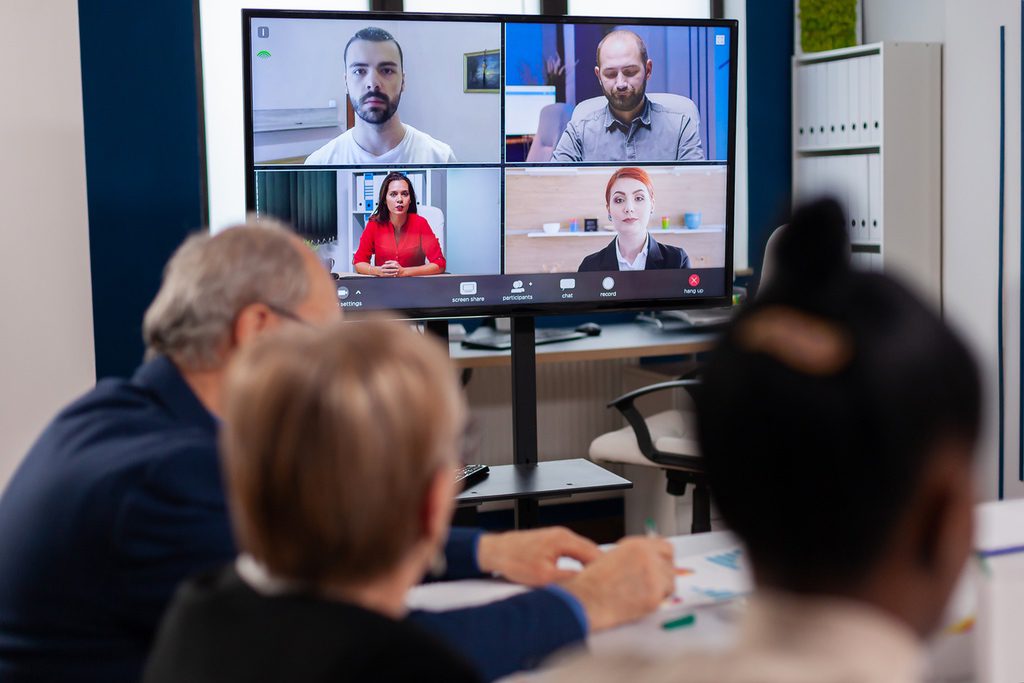
Organize a Strategy Alignment Workshop
Once you have a clear understanding of the different opinions held across your leadership team, you should plan a workshop to discuss and surface them openly. This allows members to share their perspectives with each other and promotes collaborative decision-making.
It’s important to understand the barriers that exist between your team and the strategy you want to create, but it’s also critical to avoid blame and allow everyone’s voice to be heard. Ensure that you create an environment of psychological safety, where leaders feel safe to speak their mind.
- Start with a round-table discussion where all different viewpoints are summarized briefly for the group.
- As an experiment, have leaders pair up and present their partner’s viewpoint as accurately as possible to the group. This is a great activity for fostering empathy and facilitating broader perspectives.
- Share insights from employee surveys, productivity metrics, and industry trends related to workplace models. This will inform your decision-making with objective data.
ET Group offers free workshops that help organizations to surface the potential blind spots and challenges hindering effective hybrid collaboration alongside other senior industry leaders. Register today or reach out to us for help facilitating a workshop designed for your leadership team.
Set Common Goals
Once all perspectives have been heard and understood, you can start identifying commonalities and using them to develop shared goals. Develop a list of questions that you might answer to better align your organization on its shared priorities.
- Revisit your company culture and make sure it supports the model you’re using—for example, using virtual team-building exercises if your new strategy encourages remote work.
- Evaluate your current technology and its capabilities. Is it easy to use? Does it allow your remote and in-office team members to connect seamlessly or does it create friction? Read more about how to design effective conference and video meeting rooms.
- Decide what upgrades you’ll need to make to ensure that your equipment and facilities support the new strategy.
- Determine how you’ll measure productivity under the new strategy, and put support in place for ensuring a consistent experience for all team members. We offer audio visual support services that can provide you with important insights on how your workplace technology is being used and proactively address any IT issues you experience before they impact workflow.

Develop Your Strategy
Use the answers to the questions you asked in the step above to determine a list of shared priorities. These will help guide the framework for your new workplace strategy, informing the model (remote, hybrid, in-office, etc.) you’ll use and the technology you’ll need for it.
Now you should have everything you need to draft a strategy that reflects the collective decision and aligns with business goals. For more information on this, see: How to Create a Hybrid Work Policy for Your Office.
Test and Prototype Your Workplace Strategy
When your leadership team has found consensus on how you’ll work and what technology you’ll need, you can formulate a plan to test and prototype this strategy with a wider group in your organization. Here’s an outline of the process you might follow:
- Identify pilot groups: Select smaller teams or departments within your organization to serve as pilot groups for testing the new workplace strategy.
- Define metrics for success: Clearly outline the key performance indicators (KPIs) or metrics you’ll use to evaluate the effectiveness of the new strategy within the pilot groups
- Conduct training and support: Provide adequate training and support to the pilot groups to ensure they understand the new strategy and have the necessary resources to implement it effectively.
- Gather feedback: Regularly collect feedback from the pilot groups regarding their experiences with the new strategy, including any challenges they encounter and suggestions for improvement.
- Iterate and refine: Use the feedback gathered from the pilot groups to iterate on the workplace strategy, making adjustments and refinements as necessary before rolling it out to a wider audience.
Alignment Leads to Better Outcomes
The more planning you and your leadership team do at the front end, the easier it is to create a strategy that benefits everyone at your workplace. Taking the time to understand the different views within your organization and find common ground lets you build a strategy
Use the steps above to start planning your next moves, and reach out to us for additional support. Our experts can consult with you to clarify your organization’s needs and create a specific plan to make sure the technology you use helps your people meet them.
Stay connected with us:
Follow ET Group on LinkedIn
Subscribe to ET Group’s YouTube Channel
The ‘hybrid rainbow’: how to orient your company strategy for action
Social and cultural barriers to hybrid collaboration can be more tricky to navigate than technical ones, which is why companies should go through a process of orientation to find the best route forward
Reposted article from WORKTECH Academy
Improving hybrid collaboration so that all meeting participants share a high-quality experience, irrespective of whether they are joining in-person or remotely, has become one of the defining challenges of the new world of work.
To explore this challenge in the round, Canadian workplace technology designer and integrator ET Group has teamed up with WORKTECH Academy on an article series that seeks to shake up current thinking on hybrid collaboration and test preconceptions around the issue.
In the first article in the series, a core hypothesis was presented, derived from ET Group’s digital communication projects with clients. This argued that neither investment in new technology nor redesign of meeting space would be sufficient on their own to move the dial.
Instead, the issue of meeting equality was linked – in the words of ET Group Senior Consultant Stephan Berchtold – to ‘what goes on beneath the surface of the company’. While the tech and spatial aspects of hybrid collaboration undeniably matter, the social interactions inside firms and the beliefs that underpin the structure of an organisation – termed organisational paradigms – tend to play a more critical and often unrecognised role. This thinking was captured in a presentation of ET Group’s ‘4 Pillars Model’, which has four main pillars: technology; place/space; social interaction; and organisational paradigms.
Below the waterline
Then, in our second article, we sought to validate our hypothesis in an online workshop with a group of 30 international companies drawn from WORKTECH Academy’s membership network. This confirmed that three out of four barriers to hybrid collaboration identified by workplace professionals are ‘below the waterline’, meaning that most of the barriers arise from aspects that belong to either social interaction or organisational paradigms. Yet, in many companies most of the attention goes to the more visible and tangible aspects of technology and space.
It is a situation that should give company decision-makers pause for thought, especially given current tension around bringing people back to the office or going fully remote. Where should business leaders aim their resources? Tech investment or a plan to shed office space? A focus on social interaction or a more holistic approach which embraces all four pillars? A key recommendation is to get more orientation first – and this is what this third article is all about.
Do not get us wrong, we are not arguing for an excessive analysis that leads to paralysis and never leads to action. Our observations show that very often organisations seem to be looking for solutions without really understanding what their specific situation calls for. They orient themselves around what other companies do, or at what is hyped as the latest and greatest idea on the market. Both approaches run the risk of creating a sub-optimal solution that lacks the needed fit to the specific situation of your organisation.
Getting oriented
So how can companies effectively orient themselves to get on the road to creating positive change? Here are some elements that decision makers should address:
- Understand your organisation’s barriers to hybrid collaboration: using the ‘4 Pillars Model’ is a helpful way to map the findings.
- Relate these barriers to a strategy around ways of working: do you have a shared understanding of the different options and their benefits and downsides?
- Uncover the interdependencies between barriers (mapped along the four pillars) with regards to your strategy around ways of working.
The framework below offers a way of understanding the different options that are available for companies looking into how they work and which strategy would be best for their organisation. It spans from full co-location to a remote but still synchronous way of working over to a fully distributed and asynchronous approach. ET Group senior consultant Stephan Berchtold simply calls this framework the ‘hybrid rainbow’. Accompanied by a set of questions, this tool can be used to help companies reflect on where they are on their workplace strategy journey.
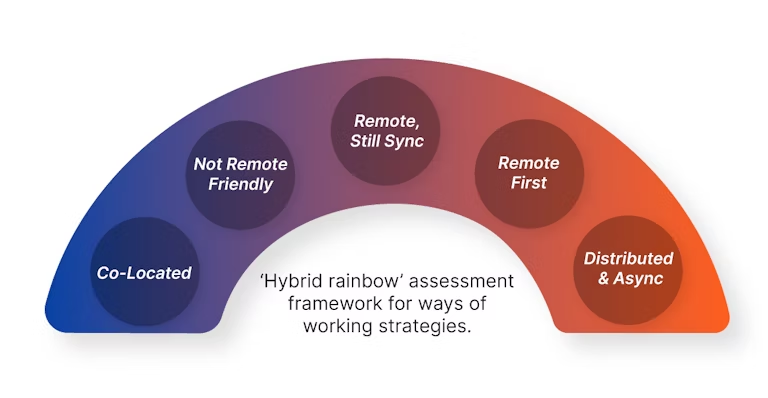
Key questions to ask
Looking at this diagram, ask yourself these questions:
- Consider your current situation. Which of the states introduced above describes best where you are now? There might be multiple states which apply to different teams in your organisation.
- Now look back one year and then two. Where were you a year ago and where were you two years ago?
- What changes have you witnessed? What is the reasoning behind these shifts? And what are some of the challenges that have resulted from these changes?
- Now look forward: where do you want to be in one year’s time? And for the bold amongst you, how about two years from now?
- Is this strategy a shared vision? Are decision makers in your organisation all aligned on the fact that this is your route forward?
The value of this assessment tool is found not only in helping organisations get a better understanding of where they are now and where they might be headed, but also in better understanding the potential tensions that could arise from a chosen approach. Companies can use this tool to align themselves better with their desired outcome and clear a way forward for collaboration.
Remember that many organisations do not sit in just one of the states, but in two, sometimes even three. This brings the challenge of finding the appropriate operational system as they have to cover a broad range.
After the orientation
Once companies have familiarised themselves with the ‘4 Pillar Model’ and oriented themselves on the ‘hybrid rainbow’ spectrum, they are now in a position to start making decisions about how they can best support their employees.
This will look very different for different companies. For example, a company in the state of ‘remote first’ which is heading towards a ‘distributed and asynchronous’ model might find that its strategy around space and facilities will look very different when compared to a company aiming to be fully ‘co-located’ in the office. While one will need (almost) no office, the other will need to invest heavily in space. With regards to investment into the technology, the set-up of meeting rooms also looks very different.
What about taking action to improve social interaction and organisational paradigms?
Consider an organisation working towards a distributed and asynchronous model of working. The impacts of this approach on social interaction are huge. This company might ask itself: how does informal communication happen within this model? How can we integrate and socialise new team members? How can formal and informal, over-the-shoulder learning happen?
When it comes to organisational paradigms, we need to address long-held beliefs and assumptions on how companies work. We might ask: how does the organisation tackle the issue of measuring productivity? What are some of the core rules and procedures that are built on the underlying assumptions and thus shape behaviour in our organisation?
‘Taking the time to orient yourself as an organisation can help facilitate decision-making…’
If the four pillars represent where the allocation of resources and money could go towards improving the hybrid collaboration experience, one thing should be clear: while going fully remote might reduce the costs of running an office space, it increases the level of resources needed to facilitate social interaction. Considering the factors involved in creating an effective hybrid working experience and taking the time to orient yourself as an organisation can help facilitate decision-making and create real impact on the experience of employees.
In the final article on our series, we will conclude by looking at implementation, with a special focus on delivering technology solutions. Once you have identified the barriers to effective hybrid collaboration and oriented yourself in the field, you can take steps towards implementing effective strategies and identifying the technologies that will support your organisational needs.
The Benefits of Using Video Conferencing Technology in Courts & Correctional Facilities
Summary
- Video conferencing technology is already changing the way justice is administered in courts and correctional facilities—making it easier to process cases, participate in hearings remotely, and deliver essential services to inmates in jails and prisons.
- As this technology becomes more widely available, it will be imperative to choose systems that focus on accessibility, cost-effectiveness, user experience, and safety.
- ET Group Justice Solutions uses features like online scheduling, virtual breakout rooms, and automated translation and transcription services to improve access for participants during court hearings and streamline cases. They can also help protect vulnerable witnesses by concealing their identity and eliminating the need for them to physically appear in courtrooms.
- Our correctional audio visual solutions can improve the quality and frequency of visits for inmates by facilitating video visitations with their loved ones. The same technology can also improve access to essential services via telehealth and remote delivery of educational programs, while removing costs and liabilities for correctional institutions.
The Benefits of Using Video Conferencing Technology in Courts & Correctional Facilities
As courtrooms and correctional facilities throughout North America face an increasing backlog in the number of cases completed and challenges related to inmate quality of life, video conferencing technology has profound potential to improve the efficiency of our justice system—from remote hearings to video visitation, telehealth, and the delivery of remote educational programs for inmates.
ET Group Justice Solutions are designed to improve both the efficiency with which these important institutions function and the experience of all people connected to them. Below, we explore five of the most important benefits video conferencing technology provides in this context.
See Also:
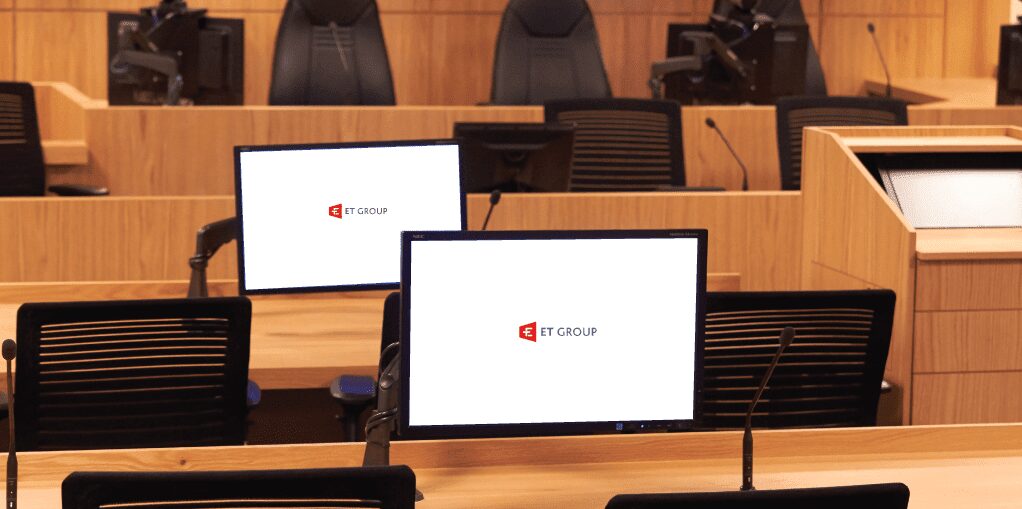
Transforming & Innovating Technology Infrastructure
Courtroom technology began to expand significantly throughout North America following the outbreak of the COVID-19 pandemic. In the United States, various groups including the Conference of Chief Justices (CCJ) and the Conference of State Court Administrators (COSCA) requested that courts use technology to improve communication for litigants during hearings.
According to the Pew Charitable Trusts, the adoption of this technology was unprecedented in both size and scale. Specifically, video conferencing was cited as an effective way to move hearings online, thereby resolving many cases that would otherwise have been delayed.
Technology that Supports Equality
Following the pandemic, it became clear that while this technology had obvious and exciting implications, it also created certain difficulties—specifically, for people with disabilities, limited English proficiency, or no access to high-speed internet. Many courts have since mandated that the use of video conferencing technology in courtrooms must “ensure principles of due process, procedural fairness, transparency, and equal access are satisfied when adopting new technologies.”
This evidence points to an urgent and ongoing need to modernize courtrooms—not only in North America but around the world. Our focus at ET Group is to promote, standardize, and simplify the virtual infrastructure that makes these kinds of efficiencies possible.
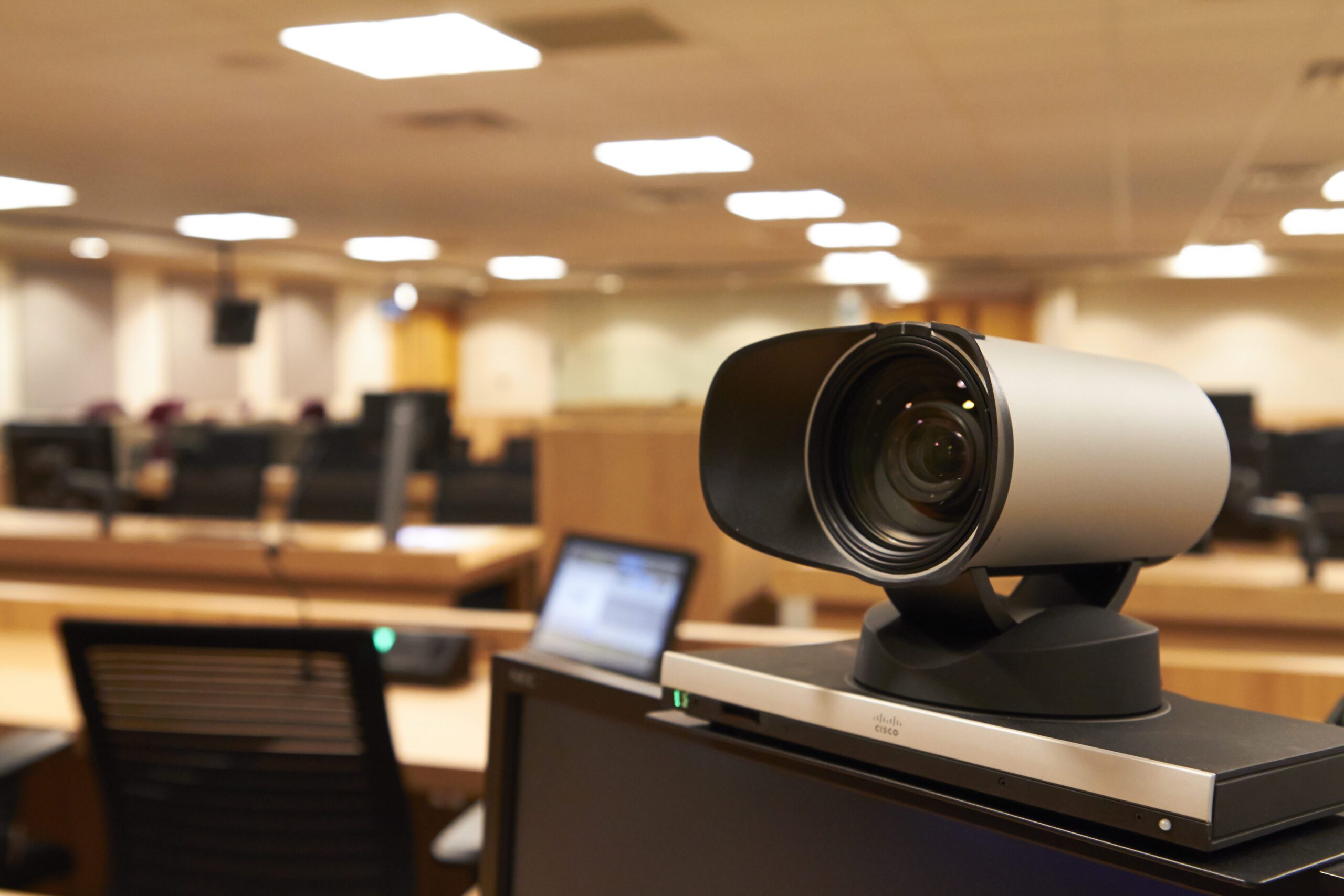
Increasing Access to Justice
One of the easiest ways to measure the success of new technology is to look at the material benefits it provides for the people who use it. That philosophy, which is at the heart of our hybrid workplace solutions for enterprise organizations, applies just as much to the technology we develop and implement for courts and correctional facilities.
At ET Group, we believe that justice is only served when it’s served equally. Here are some of the ways in which our video conferencing technology is designed to benefit litigants, inmates, and the people connected to them:
- Easier remote participation during hearings via cloud-based online scheduling and breakout rooms
- Support for people with disabilities via video recording, assistive listening, large-format displays, and audio uplift.
- Interpretation and translation services to benefit participants whose second language is English.
- Accessible cameras for video visitation stations in correctional facilities.
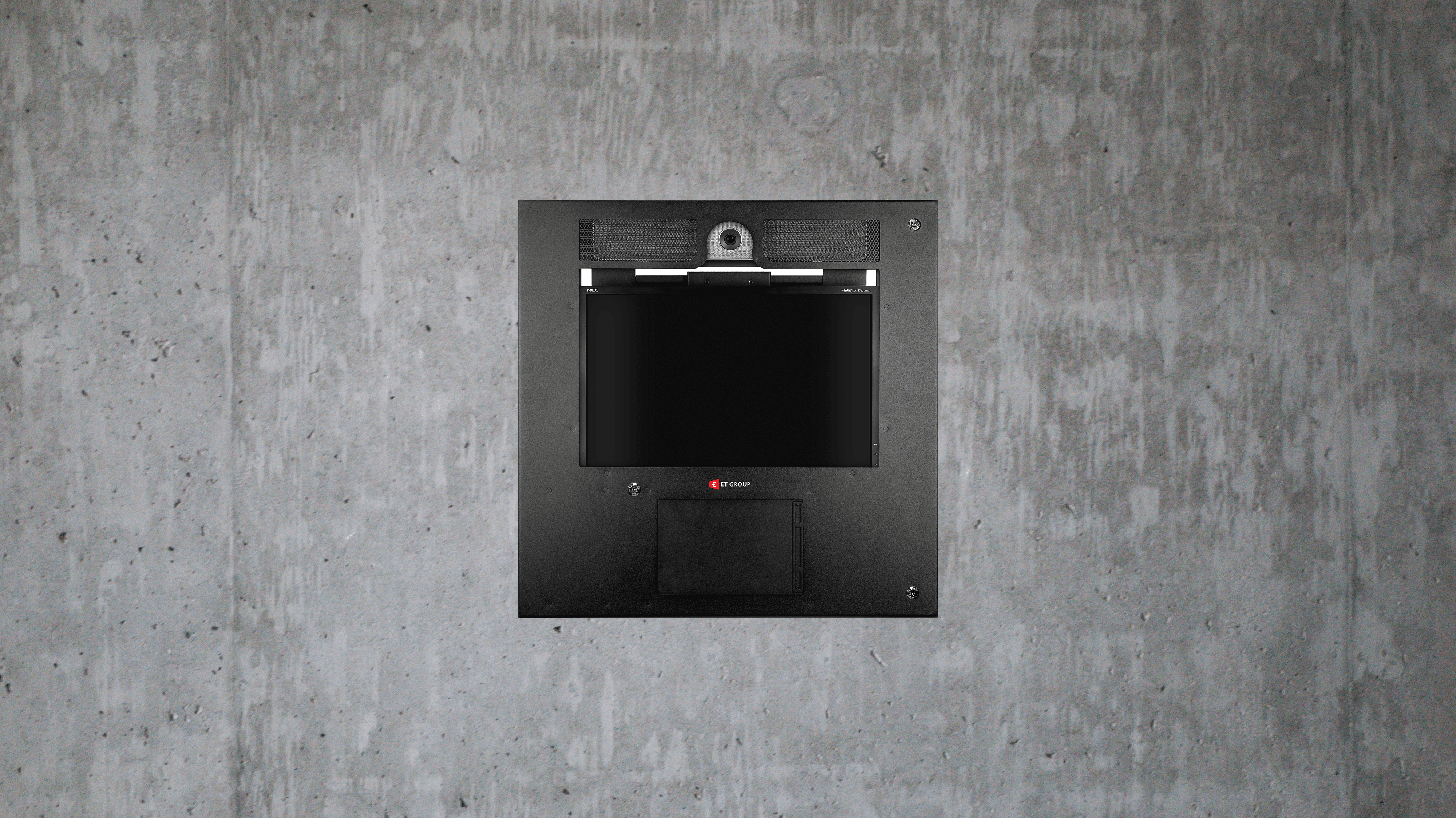

Reducing Operational Costs
Improving the efficiency of courts and correctional facilities does more than save time—it also saves money. For governments and private organizations that administer these facilities, this makes resources available to allocate towards other services and quality of life improvements. Here’s how:
- Reduces travel and transportation. Virtual courtrooms with external evidence-sharing features significantly reduce the costs of setting up hearings, and using video conferencing technology in correctional facilities eliminates the need to escort inmates to and from visitation rooms.
- Lower staffing requirements. Correctional facilities benefit significantly from video visitation technology, since it removes the need for on-site personnel to handle visitor check-in and registration.
- Increases ROI on tech infrastructure. Money saved on staffing and transportation helps offset the costs of video conferencing technology for hybrid courtrooms and correctional facilities.
Improving Service Delivery
Standardizing the video conferencing tech used across the justice system reduces the potential for compatibility issues and ensures important information is not lost while improving user experience and delivering faster results. Our solutions focus on improving service in the following ways:
- Simple and easy-to-use technology improves accessibility for all end users in courtrooms and correctional facilities. Our correctional video endpoints are designed as all-in-one units that provide a straightforward user experience in a secure and vandal-resistant package, while our FlexVideo carts offer a plug-and-play mobile courtroom video experience that can hybridize any courtroom in minutes.
- Delivering justice faster means more cases are processed and more people get closure. From making remote participation easier to automating tasks like transcription and translation, the time and resources saved by using our video conferencing solutions translate directly into faster resolutions for individuals.
- Self-service tools like the scheduling and wayfinding features in our HybridCourts™ solutions help eliminate administrative overhead for institutions while giving users agency over scheduling, submitting documentation, and more.
- Enhanced customer service experience via remote technology support designed specifically for justice applications. Our JusticeSupport™ services provide detailed analytics, remote monitoring, and room testing, and access to a dedicated help desk to proactively diagnose and address challenges—as well as 24-hour on-site support from certified AV technicians when necessary.
Increasing Safety
Ultimately, the justice system exists to provide security for people—so any video conferencing technology used in courtrooms or correctional facilities must make safety a top priority. This concept applies equally to two vital areas:
- Making justice more accessible during public emergencies like pandemics or natural disasters. The value of virtual courtroom technology in these situations is already clear, but investing in the right technology support is also vital for ensuring reliability during periods of increased uncertainty or instability.
- Improving the safety of inmates and vulnerable populations by using technology that protects essential information and reduces risk during hearings, visitations, or other activities. For example:
- Protecting vulnerable witnesses in remote courtroom hearings via multi-camera features and control systems that help prevent their identities from being revealed.
- Facilitating remote court appearances and defense access for jail inmates to eliminate the risks of transporting them in public during trials.
- Enabling remote access to healthcare, educational, and consultative services to reduce opportunities for inmates to come into conflict with each other and improve access to these services by eliminating problems related to scheduling or overcrowding.
Bringing Justice into Focus for the Modern Era
Video conferencing technology is already fundamentally transforming the way justice is administered in modern courtrooms and correctional facilities. Using this technology to its full potential requires a standardized approach that prioritizes increased access, cost-efficient technology, and a focus on service and safety.
Learn more about our HybridCourts™ and correctional video solutions by contacting ET Group Justice Solutions and speaking with an audio visual expert who can walk you through the best ways to use these tools for your organization. With our help, justice can be faster, more efficient, and available to a wider number of people than ever before.
Frequently Asked Questions about Video Conferencing Technology in Courtrooms & Correctional Facilities
Who benefits most from hybrid and virtual courtroom technology?
Hybrid courtroom technology benefits the people who administer justice and the people who rely on them. Here are a few examples:
- Remote participants (including litigants and police) via online scheduling, recordings, and virtual breakout rooms.
- Vulnerable witnesses via multi-camera technology, picture-in-picture mode, and identity protection controls.
- Juries via ceiling speakers, tracking cameras, large-format displays, and other accessibility features.
- Courtroom staff via evidence presentation tools, automated translation and transcription, mobile video carts, assistive listening, and more.
- Correctional staff and inmates via vandal-resistant devices, accessible cameras, and private calling.
What activities can correctional video technology support?
Our video conferencing systems for correctional facilities make the following activities safer, more cost-effective, and easier to coordinate:
- Remote Court Appearances: Inmates can join their court hearings from jail, without needing to be physically moved to the courtroom.
- Defense Access: Inmates can talk privately with their lawyers over video.
- Family Visitations: Video visitation technology helps inmates see and speak with their family members through video calls—and makes visitations easier for loved ones.
- Consultative Services: Offers ways for inmates to get advice or counseling over video.
- Educational Programs: Inmates can learn or train through online classes and programs.
- Telehealth: Inmates can have medical check-ups or talk to a doctor or therapist over video.
What correctional video systems does ET Group offer?
Our video conferencing hardware for correctional facilities includes a few different options:
- SecureV200 (For Cisco Webex Room Kit Mini): Best for small, confined spaces like private offices or small meeting rooms. It’s a secure, easy-to-install system with a wall-fastened cabinet and clear audio and video capabilities.
- SecureV250 (For Cisco Webex Room Kit): Similar to SecureV200, it’s also ideal for smaller rooms needing secure video conferencing solutions, with added features for clear audio transmission and durability.
- SecureV300/V300 Pro (For Cisco Webex Desk/Desk Pro): Suitable for slightly larger spaces that require more equipment storage. Offers touchscreen compatibility and enhanced security for more dynamic conferencing setups.
SecureMobile (For Cisco Webex Room Kit): Perfect for flexible, open spaces where equipment needs to be moved frequently. Offers mobility with lockable wheels and handles, along with secure and clear audio-visual capabilities.
Stay connected with us:
Follow ET Group on LinkedIn
Subscribe to ET Group’s YouTube Channel
Audio Visual Technology Adoption Starts with Better End User Training
Summary
- Effective AV tech adoption requires comprehensive end user training. The more value teams see in new technology and the more comfortable they feel using it, the more ROI your business will experience.
- The first step towards ensuring the adoption of new video conferencing technology is to understand your specific needs as an organization. This makes it easier to buy appropriate technology for your team.
- The next step is to evaluate different technology options and buy the most appropriate one for your business. Working with technology consultants can help you choose solutions that remove the potential for friction when your team members use them and reduce abandonment.
- Ongoing training and support are essential to help staff confidently use new AV systems. Investing in technology also means investing in people to ensure effective communication and collaboration.
Audio Visual Technology Adoption Starts with Better End User Training
Encouraging your team to adopt and use audio visual technology is about more than just design and deployment. At the end of the day, it doesn’t matter how useful your video conferencing system is if your team members don’t understand how to use it.
Investing in comprehensive end user training for your team shows them what your AV technology is capable of, and how to use it effectively—increasing the likelihood that they’ll adopt it and improving your ROI. As providers of custom hybrid technology solutions for organizations in a broad range of industries, our team is here to show you why workshops and consulting should always be a part of any technology investment you make for your business.
How End User Training Encourages AV Tech Adoption
Most organizations recognize the need for audio visual technology. But not having clarity on what this technology is needed for, what specific tools are being purchased, or how they’re being deployed all make large-scale adoption less likely. End user training provides clarity during each of these critical phases to ensure that organizations are set up to succeed.
Identifying Organizational Needs
There’s no such thing as one-size-fits-all AV technology—that’s why we design custom hybrid workplace solutions for each of our clients. But before we can do that, it’s vital that you understand what communication challenges your organization is trying to solve.

Example: Improving Screen Real Estate on Multi-Point Calls
Let’s say a business wants to bring three locations (Toronto, New York, San Francisco) into the same video call. This is called a multi-point call (as opposed to a point-to-point call, which takes place between just two endpoints).
Pretty much any traditional video conferencing vendor can make this happen—but wait. Now let’s say the same business has dual screens at each location, and wants each location to see the other two on separate monitors (a person in Toronto would see New York on one screen and San Francisco on the other, and so on).
Suddenly, there aren’t so many appropriate video conferencing options. That’s because most vendors use a communication protocol called H.323. When a multi-point call is made using H.323, the video streams from each location are effectively combined and sent to the other locations as a single stream.
This single video stream can only be viewed on a single screen—which causes the video images of the remote locations to shrink on the display, dramatically diminishing their value.
Bottom line: being aligned with your audio visual provider on your organization’s specific goals is the key to investing in appropriate systems. Consulting with ET Group before buying video conferencing technology would allow this business to rule out vendors offering standard H.323 solutions ahead of time, whereas skipping this step could lead towards buying technology that doesn’t work for them.
Buying the Right Technology
Once your goals are clearly defined and you’ve consulted with our experts, you’re in a position to choose tools that support your organization. To see what this might look like, let’s return to the example we introduced in the last section.

Example: Evaluating Three Potential Options for Multi-Point Video Calls
Our example business now has clarity on what they want to achieve, and knows that traditional H.323 offerings aren’t the answer. Now they need help choosing between three other options:
- Option 1: Use More than One Codec. Set up each location with two codecs and two cameras, then have each codec in the office call one of the other 2 offices. This solution works, but it’s clumsy and expensive—since it requires twice as many codecs and cameras. It also won’t scale, so if the business needs to add a fourth or fifth location later, it’ll be out of luck.
- Option 2: Invest in a High-End Telepresence Solution. This approach also requires multiple cameras and codecs at each location, but the images are stitched together and combined. The new images are then sent to each other location as a single image that can be split across both of their monitors. This type of solution offers excellent user experience, but is expensive to set up initially as it requires a substantial amount of technology and integration is relatively complex.
- Option 3: Use Newer Video Technology. If the business uses a newer video technology instead of H.323, they can deploy room systems that allow the use of a single processor (codec equivalent) to put full-screen images on both monitors in each location. These commercial video solutions are easier to scale up as well, and can even cost less than typical H.323 systems.
Bottom line: Working with technology consultants to learn about the technology available to your organization and make informed decisions prevents your team from running into challenges down the road. This removes the potential for friction and improves the likelihood that your audio visual technology will continue to be used.
Clarifying Deployments for Staff
Working with consultants to clarify your organization’s needs and educate your leadership about the different technologies available can prevent many of the problems that hamper adoption. However, you’ll still need to make sure your staff is comfortable using the new system once it’s been deployed.

Example: Encouraging Team Members to Use New Video Conferencing Systems
Let’s assume that the business in our example has opted to invest in newer video technology like SIP, an internet-based protocol that offers better scalability and flexibility.
This solves the issue of making calls between locations—but some team members may shy away from using the new technology because they’re used to older and more established protocols. While placing phone calls or sending emails to other locations may be more comfortable for some, it’s also less efficient for the business and may lead to some information being lost in translation.
Bottom line: at this point, the organization needs ongoing training to make their staff aware of the new system’s capabilities and help them feel confident using it. Workshops from ET Group can help by providing team members with essential skills for thriving in hybrid workplaces, recontracting the ways in which they work together, embracing design thinking, and more.
Investing in People Is a Prerequisite for Investing in Technology
At ET Group, we believe that technology is only useful insofar as it supports people to communicate and collaborate effectively. That’s why we consider end user training a must for organizations that want to make sure the audio visual technology they invest in is being adopted and used.
Start out by clarifying your needs and consulting with experts who can present appropriate options for meeting them—this helps you avoid many of the pitfalls that can lead to team members abandoning new technologies out of frustration. Then, follow up by providing your team with comprehensive training that helps them see how your new investment solves their pain points and gives them the competencies they need to use it effectively.
To learn more about our hybrid workplace solutions or the training we can provide for your workforce, book a discovery call with ET Group. To learn more about end user training for audio visual systems, browse the FAQ below.
Frequently Asked Questions about End User Training for AV Technology
Why can’t I buy audio visual technology without investing in end user training?
We do not recommend purchasing technology without training your personnel on how to use it effectively. This creates frustration that eventually leads to abandonment, and can also cost more in the long run by making meetings less efficient or secure.
Can tech support improve AV tech adoption?
Yes—the right support is instrumental in helping your team feel comfortable enough with new technology to adopt and use it. ET Group’s support services keep user experience consistent and productive, encouraging personnel to stay connected and collaborate with the tools you’ve purchased.
How can end user training be adapted for different skill levels?
Always purchase new audio visual technology from organizations that can provide accessible training for members of your team with different proficiencies or experience levels. ET Group offers workshops aimed at different audiences (team leaders, intact teams, etc.) so that everyone can understand how your new technologies relate to their role and find effective ways to use them.
Stay connected with us:
Follow ET Group on LinkedIn
Subscribe to ET Group’s YouTube Channel


